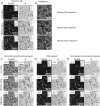Alternation of inverse problem approach and deep learning for lens-free microscopy image reconstruction
- PMID: 33214618
- PMCID: PMC7678858
- DOI: 10.1038/s41598-020-76411-9
Alternation of inverse problem approach and deep learning for lens-free microscopy image reconstruction
Abstract
A lens-free microscope is a simple imaging device performing in-line holographic measurements. In the absence of focusing optics, a reconstruction algorithm is used to retrieve the sample image by solving the inverse problem. This is usually performed by optimization algorithms relying on gradient computation. However the presence of local minima leads to unsatisfactory convergence when phase wrapping errors occur. This is particularly the case in large optical thickness samples, for example cells in suspension and cells undergoing mitosis. To date, the occurrence of phase wrapping errors in the holographic reconstruction limits the application of lens-free microscopy in live cell imaging. To overcome this issue, we propose a novel approach in which the reconstruction alternates between two approaches, an inverse problem optimization and deep learning. The computation starts with a first reconstruction guess of the cell sample image. The result is then fed into a neural network, which is trained to correct phase wrapping errors. The neural network prediction is next used as the initialization of a second and last reconstruction step, which corrects to a certain extent the neural network prediction errors. We demonstrate the applicability of this approach in solving the phase wrapping problem occurring with cells in suspension at large densities. This is a challenging sample that typically cannot be reconstructed without phase wrapping errors, when using inverse problem optimization alone.
Conflict of interest statement
C.A. and L.H. are inventors of patents devoted to the holographic reconstruction. O.C., D.C.A.K., M.M., O.M. and S.M. declare no competing interests.
Figures









Similar articles
-
CNN-Based Projected Gradient Descent for Consistent CT Image Reconstruction.IEEE Trans Med Imaging. 2018 Jun;37(6):1440-1453. doi: 10.1109/TMI.2018.2832656. IEEE Trans Med Imaging. 2018. PMID: 29870372
-
Pixel super-resolution for lens-free holographic microscopy using deep learning neural networks.Opt Express. 2019 May 13;27(10):13581-13595. doi: 10.1364/OE.27.013581. Opt Express. 2019. PMID: 31163820
-
A Physics-Inspired Deep Learning Framework for an Efficient Fourier Ptychographic Microscopy Reconstruction under Low Overlap Conditions.Sensors (Basel). 2023 Jul 31;23(15):6829. doi: 10.3390/s23156829. Sensors (Basel). 2023. PMID: 37571611 Free PMC article.
-
Focus prediction in digital holographic microscopy using deep convolutional neural networks.Appl Opt. 2019 Feb 10;58(5):A202-A208. doi: 10.1364/AO.58.00A202. Appl Opt. 2019. PMID: 30873979
-
Optical imaging in medicine: II. Modelling and reconstruction.Phys Med Biol. 1997 May;42(5):841-53. doi: 10.1088/0031-9155/42/5/008. Phys Med Biol. 1997. PMID: 9172263 Review.
Cited by
-
Detecting abnormal cell behaviors from dry mass time series.Sci Rep. 2024 Mar 25;14(1):7053. doi: 10.1038/s41598-024-57684-w. Sci Rep. 2024. PMID: 38528035 Free PMC article.
-
Machine Learning-Driven Multiobjective Optimization: An Opportunity of Microfluidic Platforms Applied in Cancer Research.Cells. 2022 Mar 5;11(5):905. doi: 10.3390/cells11050905. Cells. 2022. PMID: 35269527 Free PMC article. Review.
-
Quantifying nanoscale forces using machine learning in dynamic atomic force microscopy.Nanoscale Adv. 2022 Apr 5;4(9):2134-2143. doi: 10.1039/d2na00011c. eCollection 2022 May 3. Nanoscale Adv. 2022. PMID: 35601812 Free PMC article.
References
-
- Gabor, D. A New Microscopic Principle (1948). - PubMed
Publication types
LinkOut - more resources
Full Text Sources

